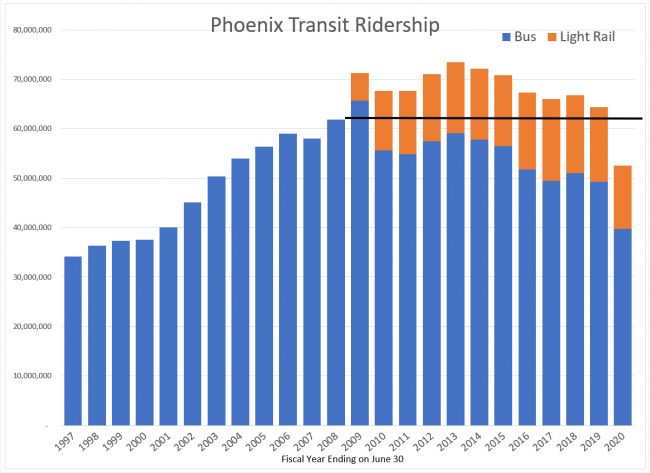Phoenix Light Rail Fail: @valleymetro 2020 Report
Well, it is that time of the year when Valley Metro, the Phoenix area transit authority, publishes its fiscal year (July-June) ridership numbers, and boy are they awful this year.
In past installments, I have pointed out how our shift to funding a ridiculous light rail system in one of the least dense cities in the world has killed transit ridership. Since rail costs more than 10x per passenger mile to move riders vs busses, the shift to light rail tends to starve bus funding in every city it has been tried, leading to net losses (even pre-Covid) in total ridership numbers -- yes even in Portlandia. This is all discussed more in our 2019 transit report. Here is a brief bit:
The problem with light rail (and the reason it is popular with government officials) is that it is an upper middle class boondoggle. There can be no higher use of transit than to provide mobility to poorer people who can't afford reliable automobiles. Buses fulfill this goal better than any mode of transit. They are flexible and can reach into many corners of the city. The problem with buses, from the perspective of government officials, is that upper middle class people don't like to ride on them. They like trains. So the government builds hugely expensive trains for these influential, wealthier voters. Since the trains are so expensive, the government can only build a few routes, so those routes end up being down upper middle class commuting corridors. As the costs mount for the trains, the bus routes that serve the poor and their dispersed commuting destinations are steadily cut.
Without further delay, here are the updated numbers including 2020. (Tellingly, Valley Metro has for some reason failed to update its chart on its ridership web page to include 2020 numbers. I wonder why?)
As you can see, even before COVID we were trending towards a total system ridership decline vs. the days before the commitment to light rail. And we certainly had killed the growth in system ridership we had seen prior to light rail. But now, with 3-4 months of COVID in the numbers, ridership has fallen off the map. Boy, I sure bet we would be better off right now with a bus only system where capacity is easier to add, subtract, and relocate vs. light rail whose costs and routes are literally sunk in the ground. I have no opinion on whether transit ridership will return to pre-COVID levels but I am sure that such massive disruptions in the system are far easier to economically manage in a bus network than in a rail network.
But you will be happy to know that Valley Metro is still spending money to put rails in the ground -- in fact, it has accelerated its spending post-COVID if you can believe it:
Phoenix is ramping up its light rail system despite record-breaking declines in ridership spurred by COVID-19.
Light rail ridership is down a little over 50% from where it was pre-COVID-19, according to Valley Metro CEO Scott Smith. Bus ridership is down about 40%.
Light rail construction hasn't slowed, however. In fact, Valley Metro has accelerated some projects, taking advantage of less vehicle traffic on the road while more people stay home.
Does this make a bit of sense? Here is the defense:
But with ridership at all-time lows and no indication as to when ridership will return at pre-pandemic levels, is it smart to continue with pricey expansion of the light rail system?
"I think if we used that same logic, we'd say 'Let's go tear down all the movie theaters and all the stadiums.' Nobody expects this to be around forever. We're going to at some point in time, whether it be in the next month or the next year, return to some normalcy," Smith said.
Ooh, @Scott_SmithAZ has obviously had an expensive education that includes lessons in how to defend a bad position using logical fallacies. Comparing expanding light rail to tearing down movie theaters is a false analogy. No one is talking about tearing out light rail (well, maybe except for me). The appropriate comparison is to ask if anyone is saying "let's go build a bunch of new movie theaters and sports stadiums" right now, and the answer is definitely no.
But don't despair, Phoenix taxpayers. Because Valley Metro is clearly carefully considering its routes and is only building those to locations they are sure will be super popular both during and after COVID. For example, one current expansion is to connect the existing network to... an aging shopping mall.
